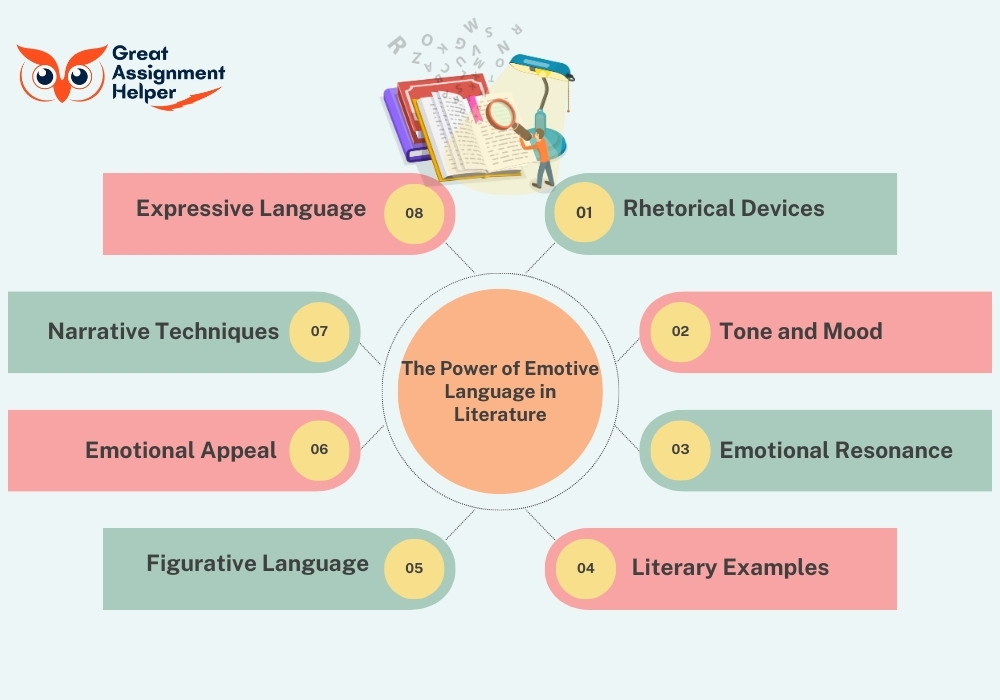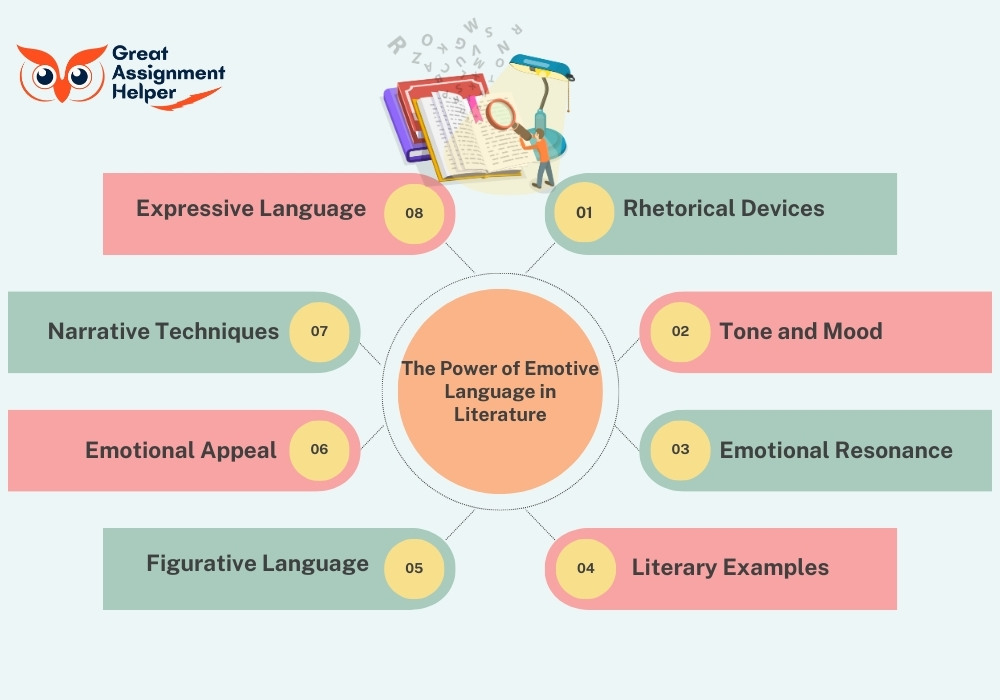
Listen To This Blog
Introduction
In the realm of literature, emotive language stands as a powerful tool that authors employ to evoke a spectrum of emotions in their readers. Delving into the intricacies of what is emotive language in literature, one finds that it's not just about the words used, but also the myriad techniques and devices that amplify their impact. From the subtle nuances of tone and mood to the more overt use of rhetorical devices, the art of crafting emotional resonance is multifaceted. Literary examples abound where authors have masterfully used figurative language, emotional appeal, and various narrative techniques to create an expressive language that resonates deeply with readers. Such techniques not only enhance the emotional impact but also aid in a richer literary interpretation. On a parallel note, the importance of emotive language in storytelling cannot be overstated. Whether it's through illustrated examples of emotive language or understanding the emotional tone in literature, the role of emotion in literary works is pivotal. As we discover and explore these concepts further, we'll also delve into how authors use emotion in writing, offering a comprehensive guide to understanding emotive expressions.
Definition of Emotive Language:
Emotive language is a powerful rhetorical device used in literature and communication to convey sentiments and evoke emotional responses in the reader or listener. It plays a pivotal role in sentiment analysis, helping to determine the tone and mood of a piece of writing. Through the use of emotive language examples, authors and speakers can create an emotional resonance, making their narratives more impactful and relatable.
This form of expressive language employs various narrative techniques, including the use of figurative language, to create an emotional appeal. Literary examples abound where emotive language has been used to great effect, enhancing the emotional expression and making the content more vivid. Such techniques not only help in conveying the intended message but also in deepening the reader's literary interpretation.
In the realm of literature, emotive language serves as one of the essential literary devices. It aids in painting a picture, allowing readers to discover and connect with the emotions of the characters. Illustrations in books often complement this, further amplifying the emotional impact. The importance of emotive language in storytelling cannot be overstated. It's the bridge that connects the reader to the story, making them feel every high and low, every joy and sorrow.
What is emotive language in literature? It's the art of using words to evoke specific emotions, guiding the reader's understanding and interpretation. The role of emotion in literary works is paramount, and through illustrated examples of emotive language, one can better grasp the depth and breadth of its influence.
In essence, emotive language is the heartbeat of expressive content, whether in books, speeches, or everyday conversations. It's the tool that authors use to breathe life into their narratives, ensuring that their message resonates deeply with their audience. So, the next time you come across a piece of writing that moves you, remember the power of emotive language techniques with examples and the profound role they play in shaping our emotional experiences.
Read More Blog: Learn How to Write a Counter Argument Paragraph
The Power of Emotive Language in Literature

Emotive language is a potent tool in the literary world, allowing writers to convey deep emotions, set the tone, and resonate with readers on a profound level. This language technique is not just about using emotionally charged words but also about employing various literary devices and techniques to evoke specific feelings and reactions.
Rhetorical Devices: These are techniques that writers use to persuade or impress their readers. They can amplify the emotional resonance of a piece, making the content more impactful.
Tone and Mood: The tone refers to the writer's attitude towards the subject, while the mood is the atmosphere created in the piece. Both play a crucial role in determining how readers will emotionally respond to the content.
Emotional Resonance: This is the ability of a piece of writing to evoke strong feelings or emotions in the reader. When a narrative resonates emotionally, it becomes memorable and impactful.
Literary Examples: Throughout history, many literary works have effectively used emotive language. From Shakespeare's passionate sonnets to the poignant speeches of Martin Luther King, Jr., the power of emotional expression is evident.
Figurative Language: This involves using words or expressions that differ from the conventional interpretation to convey complex emotions. Metaphors, similes, and personifications are examples of this.
Emotional Appeal: By appealing to the readers' emotions, writers can persuade, inspire, or evoke specific reactions. This appeal can be a driving force behind the success of a narrative.
Narrative Techniques: These are methods employed by writers to tell their stories. The way a story is structured or presented can significantly influence the emotional impact it has on its readers.
Expressive Language: This refers to words or phrases that convey emotion. Such language paints vivid pictures, helping readers feel what the characters are experiencing.
Literary Interpretation: This is the process of analyzing and understanding the deeper meanings behind literary works. Emotive language plays a significant role in shaping these interpretations.
Discovering Emotive Language: Emotive language is everywhere, from classic literature to modern narratives. It's in the way authors describe settings, characters, and events. It's in the emotional expression that gives depth to a story.
Emotional Expression: This is the heart of emotive language. It's about conveying feelings, whether it's the joy of a character achieving their dreams or the sorrow of a tragic loss.
Literary Devices and Language Techniques: These are tools that writers use to enhance their narratives, making them more engaging and emotionally resonant.
Emotional Impact: The ultimate goal of using emotive language is to leave a lasting impression on the reader, making them reflect, feel, and even act.
Literary Analysis: Delving deep into literary works to understand the use of emotive language can offer insights into the human psyche and the universality of emotions.
Understanding Emotive Language: Emotive language is more than just using 'sad' or 'happy' words. It's about understanding the nuances of emotional expression, the importance of emotive language in storytelling, and how authors use emotion in writing. It's about recognizing the role of emotion in literary works and appreciating the illustrated examples of emotive language. By diving deep into understanding the emotional tone in literature, readers can better connect with narratives, making reading a more enriching experience.
Uses of Emotive Language in Literature and Communication
Emotive language, as the name suggests, is a form of expression that evokes emotion in the reader or listener. It's a powerful tool used by writers, speakers, and communicators to make their content more impactful and relatable. But how is it employed in various contexts? Let's delve into its multifaceted applications.
- Sentiment Analysis: In the digital age, understanding public sentiment is crucial for businesses and researchers. Emotive language plays a pivotal role in sentiment analysis, helping algorithms gauge the emotional tone of user-generated content.
- Rhetorical Devices: Emotive language enhances rhetorical devices, making arguments more persuasive. For instance, a politician might use emotive terms to rally support or criticize opponents.
- Tone and Mood: Writers use emotive language to set the tone and mood of their work. Whether it's a melancholic poem or an exhilarating adventure story, the choice of words can drastically influence the reader's emotional experience.
- Emotional Resonance: For content to resonate, it must strike an emotional chord. Emotive language helps achieve this, making narratives more memorable and impactful.
- Literary Examples: Classics, from Shakespeare to contemporary novels, are replete with emotive language. It's what makes tragedies heart-wrenching and comedies uproarious.
- Figurative Language: Metaphors, similes, and other figurative devices often rely on emotive language to convey abstract concepts in relatable terms.
- Emotional Appeal: Advertisers and marketers use emotive language to appeal to consumers' emotions, making products or ideas more enticing.
- Narrative Techniques: Storytellers employ emotive language to enhance various narrative techniques, be it foreshadowing, flashbacks, or character development.
- Expressive Language: Beyond literature, everyday communication benefits from emotive language. It helps individuals express feelings, share experiences, and connect on a deeper level.
- Literary Interpretation: Critics and scholars use emotive language to interpret and analyze literary works, shedding light on the emotional depth and nuances of texts.
- Literature and Emotion: Literature is a reflection of human experience, and emotion is intrinsic to that experience. Emotive language helps authors depict the vast spectrum of human emotions, from the depths of despair to the heights of ecstasy.
- Discovering Emotion in Texts: Emotive language aids readers in discovering and relating to the emotions embedded in texts, enhancing comprehension and empathy.
- Illustrations of Emotion: Through emotive language, authors provide vivid illustrations of characters' feelings, making them more three-dimensional and relatable.
- Emotional Expression in Writing: Writing is an outlet for emotional expression. Emotive language empowers writers to convey their deepest feelings, fears, and aspirations.
- Language Techniques for Emotion: Various language techniques, from alliteration to onomatopoeia, can be enhanced with emotive language to evoke specific emotions.
- Understanding Emotional Tone: Emotive language provides readers with cues about the emotional tone of a piece, be it sarcastic, sincere, joyful, or mournful.
- Role of Emotion in Storytelling: Emotion drives narratives. Emotive language ensures that readers not only understand but also feel the emotions driving characters and plots.
- Guide to Emotive Expressions: Emotive language serves as a guide, helping readers navigate the emotional landscape of a text, understanding its highs and lows.
- Emotive Techniques with Examples: From books to articles, examples of emotive language techniques abound, serving as invaluable tools for budding writers.
- Emotion's Role in Literary Works: Literature seeks to mirror life. Emotive language ensures that this reflection captures the emotional essence of human existence.
In essence, emotive language is a bridge between the writer and the reader, a tool that ensures that the emotional depth of a piece is not only conveyed but also felt. Whether you're reading a classic novel, a news article, or a product advertisement, the emotive language is at work, shaping your emotional response and enhancing your engagement.
Power and Impact of Emotive Expressions in Literature

In the vast realm of literature, the art of conveying emotions is paramount. Authors and writers have long harnessed the potential of emotive language to breathe life into their narratives, making them resonate deeply with readers. But what makes emotive language so impactful? Let's delve into its benefits and understand its profound influence.
- Rhetorical Devices Enhance Persuasion: Through the strategic use of emotive expressions, authors can employ various rhetorical devices that make their arguments more compelling. This not only strengthens their narrative but also persuades the reader to align with the author's perspective.
- Setting the Tone and Mood: Emotive language plays a pivotal role in establishing the tone and mood of a piece. Whether it's a melancholic poem or an exhilarating adventure, the choice of words can transport readers into the intended emotional landscape.
- Creating Emotional Resonance: Words that evoke emotions create a lasting impact. They resonate with readers, making them feel the joy, sorrow, excitement, or dread experienced by the characters, forging a deeper connection with the narrative.
- Rich Literary Examples: From Shakespeare's passionate sonnets to the poignant speeches of Martin Luther King, Jr., literary history is replete with examples where emotive language has been the cornerstone of memorable pieces.
- Employing Figurative Language: Metaphors, similes, and personifications are tools that authors use to paint vivid imagery. Emotive language amplifies the effect of these figurative expressions, making the narrative more vivid and relatable.
- Harnessing Emotional Appeal: By appealing to the readers' emotions, authors can make their narratives more persuasive and memorable. This emotional appeal can sway opinions, inspire action, or provide solace.
- Narrative Techniques for Depth: Emotive expressions enhance various narrative techniques, adding depth and layers to the story. Whether it's foreshadowing, flashbacks, or character introspection, the emotional undertone makes them more impactful.
- Expressive Language Brings Authenticity: Characters and narratives become more authentic when they express genuine emotions. It makes them relatable, allowing readers to see reflections of their own experiences and feelings.
- Aiding Literary Interpretation: Emotive language provides readers with cues for interpreting the underlying themes, morals, and messages in a story. It acts as a guide, helping readers navigate the emotional complexities of the narrative.
- Emotional Impact Leaves a Mark: The stories that stay with us are the ones that make us feel. Through emotive language, authors ensure that their narratives leave an indelible mark on the readers' hearts and minds.
In conclusion, understanding the nuances of emotive language is crucial, not just for appreciating literary works but also for recognizing its role in everyday communication. From the classics to modern literature, from the importance of emotive language in storytelling to its role in evoking emotions, this powerful tool has shaped narratives, influenced perceptions, and touched countless hearts. Additionally, its interplay with poetic devices further enriches the tapestry of literature, making it a vital element in the world of written expression.
Read More Blog: 175 Extemporaneous Speech Topics for Students
Sentiment Analysis and Emotive Language
Sentiment analysis is a powerful tool that delves into the emotional undertones of written content. Through the use of emotive language, writers can convey feelings, moods, and attitudes, making their content more relatable and impactful.
Rhetorical Devices and Emotive Language
Rhetorical devices, when combined with emotive language, can persuade and move an audience. For instance, using a rhetorical question like, "Isn't the power of emotive language examples evident in every touching story?" can emphasize the importance of emotion in storytelling.
Tone, Mood, and Emotional Resonance
The tone and mood of a piece can be significantly influenced by emotive language. A well-chosen phrase can create a deep emotional resonance, making readers feel the joy, sorrow, or excitement described. This is evident when we explore examples of emotional language in books, where authors craft moods that linger with readers long after the story ends.
Literary Examples and Figurative Language
From Shakespeare to modern novelists, literary examples abound where emotive language has been used effectively. Figurative language, like metaphors and similes, can evoke vivid imagery and emotions, enhancing the emotional appeal of the narrative.
Emotional Appeal and Narrative Techniques
A story's emotional appeal is often its most memorable aspect. Through various narrative techniques, authors can guide readers on an emotional journey, making them feel every high and low of the characters. This is why the importance of emotive language in storytelling cannot be overstated.
Expressive Language and Literary Interpretation
Expressive language gives depth to characters and situations. It allows for a richer literary interpretation, where readers can find multiple layers of meaning and emotion in the text. For instance, understanding the emotional tone in literature can provide insights into the author's intentions and the narrative's underlying themes.
Discovering Emotive Language in Literature
Literature is a treasure trove of emotive language. From the subtle emotional expression in poetry to the overt emotional impact in dramatic scenes, literature showcases a plethora of emotive language techniques with examples. The role of emotion in literary works is pivotal, offering readers a chance to connect deeply with the narrative.
Concepts, Illustrations, and Emotional Impact
The concept behind a story or poem often revolves around human emotions. Illustrations, both literal and figurative, can enhance the emotional impact of the narrative. For instance, illustrated examples of emotive language can provide visual cues, amplifying the emotions conveyed through words.
Language Techniques and Literary Analysis
Language techniques, such as alliteration, assonance, and onomatopoeia, can be used to emphasize emotive language. A thorough literary analysis often reveals the intricate ways in which authors use these techniques to enhance the emotive quotient of their work.
In conclusion, emotive language is a powerful tool in the hands of writers. Whether you're trying to understand its nuances or looking to enhance your own writing, recognizing and appreciating its influence is essential. After all, it's the emotions that stories evoke that make them timeless and universally relatable.
Emotive Language in Literature: A Deep Dive into Emotional Resonance
Literature has always been a mirror to human emotions, reflecting the deepest sentiments, desires, and fears of society. Through the use of emotive language, authors have the power to evoke a spectrum of feelings in their readers, from joy and sorrow to anger and empathy. But how do they achieve this emotional resonance? Let's explore.
Rhetorical Devices and Emotional Appeal:
Authors often employ rhetorical devices to enhance the emotional appeal of their work. These tools, when combined with emotive language, can amplify the sentiment of a piece, making readers feel a deeper connection to the narrative. For instance, a rhetorical question can make readers ponder, while metaphors can paint vivid emotional pictures.
Tone, Mood, and Emotional Resonance:
The tone and mood set the emotional atmosphere of a literary piece. Whether it's the melancholic tone of a tragic play or the uplifting mood of a romantic novel, the chosen tone can guide the reader's emotional journey. This emotional resonance is what makes certain literary works unforgettable.
Literary Examples and Emotional Expression:
Consider Shakespeare's use of emotive language in his sonnets. Phrases like "Shall I compare thee to a summer's day?" not only showcase figurative language but also evoke strong emotional responses. Such examples of emotional language in books demonstrate the power of words to touch the human soul.
Figurative Language and Literary Devices:
Figurative language, including metaphors, similes, and personification, allows authors to express complex emotions in creative ways. These literary devices, combined with emotive language, can magnify the emotional impact of a narrative, making readers feel as if they're experiencing the emotions firsthand.
Narrative Techniques and Emotional Impact:
The way a story is told, its narrative technique, can influence how readers perceive and react to the emotions within. First-person narratives can offer intimate insights into a character's feelings, while third-person narratives might provide a broader emotional landscape.
Expressive Language and Literary Interpretation:
Expressive language dives deep into the nuances of emotions. It's not just about stating feelings but expressing them in a way that readers can interpret and relate to. This interpretative aspect allows readers to find their own emotional connections to a story.
Discovering Emotion in Writing:
To truly understand emotional tone in literature, one must delve into the myriad ways authors use emotive language. From the subtle to the overt, these expressions shape our reading experience. The importance of emotive language in storytelling cannot be overstated. It's what transforms a simple tale into an emotional journey.
Illustrated Examples and Language Techniques:
Visual illustrations can complement emotive language, adding another layer of emotional depth. For instance, graphic novels or illustrated classics can combine imagery with emotive language techniques, creating a rich tapestry of emotion.
The Role of Emotion in Literary Works:
Emotion is the heartbeat of literature. Whether it's the raw passion of a love story or the seething anger in a political satire, emotion drives the narrative. Authors harness this power through emotive language, making readers not just observers but participants in the emotional journey.
Conclusion:
Emotive language is a potent tool in literature, allowing authors to convey emotions with depth and authenticity. By understanding the various techniques and devices used, readers can appreciate the role of emotion in literary works and the profound impact it has on the human psyche.
How to Develop Emotive Language Writing Skills?
Emotive language is a powerful tool in the realm of literature and communication. It's the art of using words to evoke emotions, create emotional resonance, and make content more persuasive. But how can one hone this skill? Here's a comprehensive guide:
- Understand the Concept: At its core, emotive language is about expressing emotions. Dive deep into the concept of emotive language, understanding its nuances, and how it differs from regular language.
- Study Literary Examples: One of the best ways to grasp emotive language is by studying examples of emotional language in books. Renowned authors have a knack for using emotive language techniques with examples that can serve as a learning platform.
- Discover Rhetorical Devices: Rhetorical devices are techniques authors use to convey their message more persuasively. Familiarize yourself with these devices to enhance the emotional appeal of your writing.
- Master Tone and Mood: The tone and mood of a piece play a pivotal role in setting the emotional backdrop. By understanding the emotional tone in literature, you can better convey feelings and sentiments.
- Harness Figurative Language: Figurative language, like metaphors and similes, can add depth to your writing. They not only beautify the content but also intensify the emotional impact.
- Narrative Techniques: Storytelling is an art, and the way a story is narrated can influence its emotional resonance. Learn various narrative techniques to weave emotions seamlessly into your tales.
- Embrace Expressive Language: Go beyond the ordinary. Use expressive language to paint vivid pictures and evoke strong emotions in your readers.
- Literary Interpretation: Dive into literary analysis. Understand how different authors use emotion in writing and the role of emotion in literary works. This will give you a broader perspective on emotive expressions.
- Experiment and Practice: Like any other skill, mastering emotive language requires practice. Write regularly, experiment with different emotional expressions, and seek feedback.
- Stay Updated: The world of literature is vast. Continuously discover new works, illustrations, and techniques. This will not only enhance your knowledge but also provide fresh perspectives.
In conclusion, emotive language is more than just a set of words. It's about connecting with the reader on an emotional level. By understanding what is emotive language in literature and how authors use it, you can craft content that not only informs but also moves the reader. Remember, the importance of emotive language in storytelling cannot be overstated. It's the bridge that connects the author's emotions to the reader's heart.
Wrapping Up
Emotive language, deeply rooted in literature, serves as a bridge between the writer's intent and the reader's emotional response. Through the use of rhetorical devices, tone, mood, and narrative techniques, authors craft stories that resonate emotionally with their audience. Figurative language and expressive language amplify this resonance, allowing readers to delve deeper into the literary interpretation.
The concept of emotive language isn't just confined to literature; it's a reflection of our emotional expression, amplified by various language techniques. When we discover new literary examples, we're often struck by their emotional impact, a testament to the power of literary devices. Illustrations in literature, whether through emotional appeal or literary analysis, further enhance our understanding and connection to the text.
For those looking to delve deeper into the nuances of English literature and emotive language, there are resources available. Whether you need assignment writing help, English assignment help, or any other form of assignment help, there are platforms dedicated to assisting you in your literary journey.
Read More Blog:

